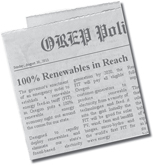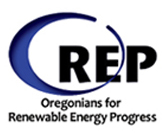Tar Sands Oil or the Right FIT?
This winter President Obama will make the decision whether or not to allow construction of the Keystone XL pipeline from Alberta, Canada to the Gulf coast. The plan is to transport hot, abrasive tar sands extract 1300 miles across sensitive aquifers to southern refineries.
Is this really a sane way to meet our transportation and energy needs? We think not. Climate change is an urgent issue and it is our generation's moral imperative to address it.
Dr. James Hansen, director of NASA Goddard Institute for Space Studies, warns that, “Phasing out emissions from coal is itself an enormous challenge. However, if the tar sands are thrown into the mix, it is essentially game over.”
Only a century ago, in the early 1900’s most urban centers in our country had efficient, mass transit systems powered by electricity. These electric trolleys served inner-city as well as inter-city travelers. A Trolley Honeymoon recounts the 1904 wedding trip of Clinton and Louisa Lucas, “a five-hundred-mile electric excursion from Delaware to Maine accomplished, with a brief interruption of railroad travel, wholly by trolleys.”* But in the quarter century from 1925 to the late 1940s, most of these efficient, clean transportation networks were dismantled in favor of combustion powered private automobiles, buses for mass transit, and diesel locomotives for freight.
Electric vehicles can be used for transportation and energy storage as part of a modern electric grid, powered by renewable energy.
Denmark is a global leader in electric vehicle-to-grid (V2G) energy storage technology and implementation of an advanced electric grid. A pilot program started in September 2011 allows participants “to sell [stored] power back to the grid through their EV batteries and earn up to about $10,000 over the lifespan of the car in compensation." Denmark has a higher proportion of renewables on its grid than any other nation. With a goal to be fossil fuel free by 2050, Denmark was an early adopter of feed-in tariffs as a policy mechanism for rapidly ramping up renewable energy production.
Experience across the globe demonstrates that a renewable energy feed-in tariff is the most successful policy to rapidly increase supplies of clean electricity. A well-designed FIT requires utilities to purchase all electricity fed into the grid from customer-generated renewables.
FITs pay everyone a pre-determined fixed price designed to cover costs plus a reasonable return on investment, instead of project-specific prices negotiated by individual agreements. This removes a significant barrier for small and medium producers, allowing you and I to compete on a level playing field with large commercial developers who can better afford costly negotiations. FIT prices are published in advance and anyone willing to accept the offered price is guaranteed a contract. This is why FITs are said to "democratize the grid."
FITs are successful because they attract private capital and rapidly open the market to all potential renewable energy producers. They provide investment security to lenders since customer-generators have guaranteed revenue sufficient to ensure loan repayment.
Germany’s 12-year experience with FIT policies has established it as a global leader in renewable energy generation, building robust industries and creating hundreds of thousands of local, family-wage jobs. Their solar industry alone employs over 100,000 people. Renewables currently supply almost 20% of their electricity at an additional cost equal to about a beer per month per household. They expect a 38% share of renewables by 2020. This fourth-largest economy in the world recently announced it will shut down its nuclear industry by 2022.
Ontario, Canada, near neighbor to tar sands-rich Alberta, leads the way on FIT policy in North America with their Green Energy and Green Economy Act of 2009. In 2010 the program accepted 22,000 installation applications initiating 5,000 MW of renewable energy, created 43,000 jobs and attracted $9B in private capital. The ratepayer impact for all that clean energy? About the cost of a doughnut per month added to customer electric bills.
Countries from Japan to Malaysia to Mongolia to Switzerland have instituted FIT policies to rapidly deploy renewables. The EU as a whole, where FITs are the rule, now boasts 85GW installed wind power capacity and 28GW of solar PV, compared to the U.S. with 40 GW installed wind and 2GW of solar PV.
Importing oil from Alberta’s Tar Sands would continue the trajectory toward global climate disaster; yet we have a better alternative – electric vehicles interacting with a modern grid, powered by renewables. The time is now to rapidly adopt FIT policy throughout the United States to meet existing and increased electricity demand.
So what is the hold-up? To quote Herman Scheer, former parliamentarian and architect of Germany’s successful feed-in tariff law, “It’s only a question of political will.”
Ray Neff, OREP


